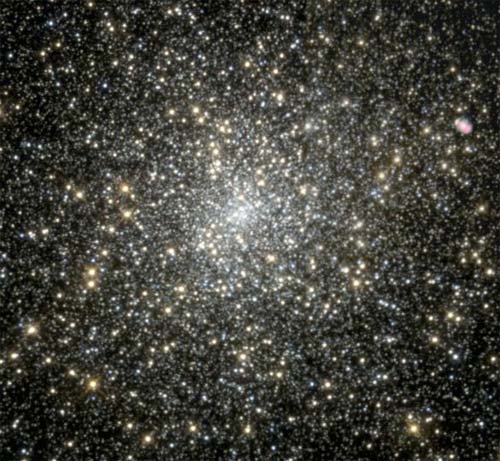







| BOOKS | F. A. Q. | ARTICLES | TALKS | ABOUT KEN | DONATE | BEYOND OUR KEN |
|---|

By Ken Croswell
The bright globular cluster M15 is easy to see in binoculars. It houses what seems to be the first interstellar gas ever found in a globular cluster. Image Credit: NASA and The Hubble Heritage Team (STScI/AURA)
Published on Astronomy.com (November 11, 2005).
Astronomers have detected what may be the first interstellar gas ever found in a globular cluster. However, the amount of gas falls far short of theoretical predictions.
Globular clusters ought to have lots of interstellar gas. After all, they have lots of stars, and their brightest stars, red giants, lose lots of mass. But past searches for gas between globulars� stars have come up dry.
Now Jacco van Loon and Aneurin Evans, both of Keele University in England, Sne�ana Stanimirović of the University of California at Berkeley, and Erik Muller of Arecibo Observatory in Puerto Rico have tentatively detected neutral hydrogen gas in M15, a bright but extremely metal-poor globular cluster in Pegasus. The cluster is 34,000 light-years from Earth.
Van Loon and his colleagues chose to study M15 because they recently found interstellar dust there. M15 is also one of the few globular clusters with a planetary nebula--a bubble of gas that a red giant star sheds when metamorphosing into a white dwarf.
To search M15 for interstellar gas, the astronomers used the Arecibo radio telescope in September 2004. They detected 21-centimeter-long radio waves, the hallmark of neutral atomic hydrogen gas. Moreover, the velocity and velocity dispersion of this gas match those of M15. Thus, the gas probably belongs to the cluster rather than lying in front of or behind it. (The gas is not part of M15's planetary nebula because the planetary nebula's velocity differs by more than 20 kilometers per second from that of the gas.)
The amount of gas is paltry, though: only 0.3 solar mass. Theory predicts all the red giants in a globular cluster should produce roughly 100 solar masses of gas before the cluster crosses the Galactic plane. At that time, gas in the Milky Way's plane hits cluster gas and removes it.
Where did M15's gas go? Van Loon and his colleagues suggest various possibilities. Perhaps radiation pressure from all of M15's starlight casts the gas out of the cluster. In addition, the cluster's red giants launch their gas into space with some velocity. In 1991, Andrea Dupree of the Harvard-Smithsonian Center for Astrophysics and her colleagues discovered that a metal-poor giant star named HD 6833 lost mass at a high speed. They noted that if the star were in a globular cluster, its gas would quickly escape the cluster's gravity.
Another possibility exists. Like most globular clusters, M15 belongs to the Galaxy's halo. As M15 travels through the halo, halo gas may ram into M15's gas and remove it.
Previously, the astronomers had detected 0.0005 solar mass of interstellar dust in M15. Thus, M15 has a gas-to-dust ratio of 600, about 3 times higher than the ratio in the envelope of a red giant with the Sun�s metallicity. A higher gas-to-dust ratio in M15 makes sense: dust consists mostly of heavy elements, and M15's abundance of these elements is only 1/180 of the Sun�s.
Van Loon's team searched four other globular clusters but made possible detections of neutral atomic hydrogen gas in only two--M2 in Aquarius and Palomar 13 in Pegasus. The astronomers searched for interstellar OH as well but failed to find it in any of the clusters, including M15.
Van Loon and his colleagues will publish their work in a future issue of Monthly Notices of the Royal Astronomical Society.
Ken Croswell earned his Ph.D. for studying the Galactic halo and is the author of Magnificent Universe and The Alchemy of the Heavens.
"Elegant and eloquent"--Washington Post. See all reviews of Magnificent Universe here.
"An engaging account of the continuing discovery of our Galaxy...wonderful." --Owen Gingerich, The New York Times Book Review. See all reviews of The Alchemy of the Heavens here.
| BOOKS | F. A. Q. | ARTICLES | TALKS | ABOUT KEN | DONATE | BEYOND OUR KEN |
|---|